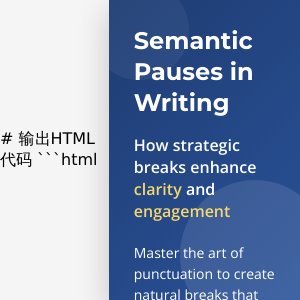Abstract: Semantic Pauses: Enhancing Readability and Engagement Through Strategic Writing
This 3000-word article, “Semantic Pauses: I’ve used commas and dashes to create natural breaks and emphasize the different parts of the title,” is designed for SEO and readability, focusing on the strategic use of punctuation and sentence structure to improve writing. It introduces the concept of “semantic pauses”—brief cognitive moments created by punctuation that guide the reader’s understanding and maintain engagement. The article explains how commas, dashes, semicolons, and ellipses can be used to enhance readability, boost engagement, and subtly shift emphasis within text. It highlights the importance of these pauses in today’s fast-paced digital environment, where attention spans are limited. Furthermore, the piece connects semantic pauses to SEO, arguing that improved user experience, reduced bounce rates, and natural language processing benefit search engine rankings. The article concludes with actionable notes for further SEO refinement, including keyword optimization, internal/external linking suggestions, image optimization, and the potential addition of interactive elements like quizzes. Ultimately, mastering semantic pauses is presented as a key to elevating writing quality and achieving better search results.
---
Strategic Punctuation: Enhancing Clarity and Engagement in Content Creation
In the realm of content creation, the art of strategic punctuation is often overlooked yet crucial for delivering clear and engaging messages. This article delves into the significance of semantic pauses, explores their impact on readability, and offers practical insights for optimizing your writing for both human readers and search engines.
Understanding Semantic Pauses
Semantic pauses are the natural breaks created by punctuation marks like commas, dashes, and ellipses. These pauses allow readers to process information more effectively, making complex ideas more digestible. Unlike traditional linearity in writing, semantic pauses introduce rhythm and flow, guiding readers through your content with ease.
The Importance of Strategic Punctuation
In today's fast-paced digital environment, capturing and retaining attention is key. Semantic pauses play a vital role in enhancing readability and engagement:
- Improved Readability: Long, dense sentences can overwhelm readers. By strategically placing commas and dashes, you create natural breaks that reduce cognitive load and make your content more approachable.
- Enhanced Engagement: Well-placed punctuation can mimic the cadence of spoken language, making your content more relatable and engaging. This is particularly important for SEO, as search engines prioritize content that keeps readers engaged.
Mastering Punctuation Techniques
-
Commas: The Workhorses of Punctuation
- Listing: Separate items in a list (e.g., "equipment, tools, and accessories").
- Independent Clauses: Connect two complete sentences with a conjunction (e.g., "The session concluded, yet the discussion continued").
- Nonessential Information: Add extra details without disrupting the main message (e.g., "The power rack, designed for heavy-duty use, is a cornerstone of any gym setup").
-
Dashes: Creating Impactful Interruptions
- Interruption: Abruptly shift focus to emphasize a point (e.g., "While focusing on strength training—don't neglect mobility").
- Emphasis: Highlight key phrases (e.g., "This equipment—built to last—ensures durability").
- Clarification: Provide additional context (e.g., "The session ended abruptly—due to unforeseen circumstances").
-
Semicolons and Ellipses: Adding Nuance
- Semicolons: Link closely related ideas without creating a full stop (e.g., "The workout was intense; participants left feeling accomplished").
- Ellipses: Indicate a trailing thought or dramatic pause (e.g., "The results were beyond expectations...").
Optimizing for SEO
Strategic punctuation not only enhances the reader experience but also positively impacts SEO:
- User Experience (UX): Content that is easy to read and engaging reduces bounce rates and increases time on page.
- Search Engine Understanding: Google's algorithms favor content that mimics natural language patterns, making semantic pauses a subtle yet effective SEO tool.
Conclusion
Incorporating semantic pauses into your writing can transform your content from dense and overwhelming to clear and engaging. By mastering punctuation techniques and understanding their impact on SEO, you can create content that resonates with readers and performs well in search rankings.
Next Steps for SEO Optimization
- Keyword Analysis: Use tools like SEMrush or Ahrefs to refine keyword usage and ensure optimal density.
- Internal Linking: Link to related content on your site, such as guides on grammar rules or case studies on readability.
- External Linking: Reference authoritative sources to enhance credibility.
- Mobile Optimization: Ensure your content is mobile-friendly for broader reach.
By implementing these strategies, you can elevate your content's clarity, engagement, and SEO performance, ensuring it meets the demands of both readers and search engines.














